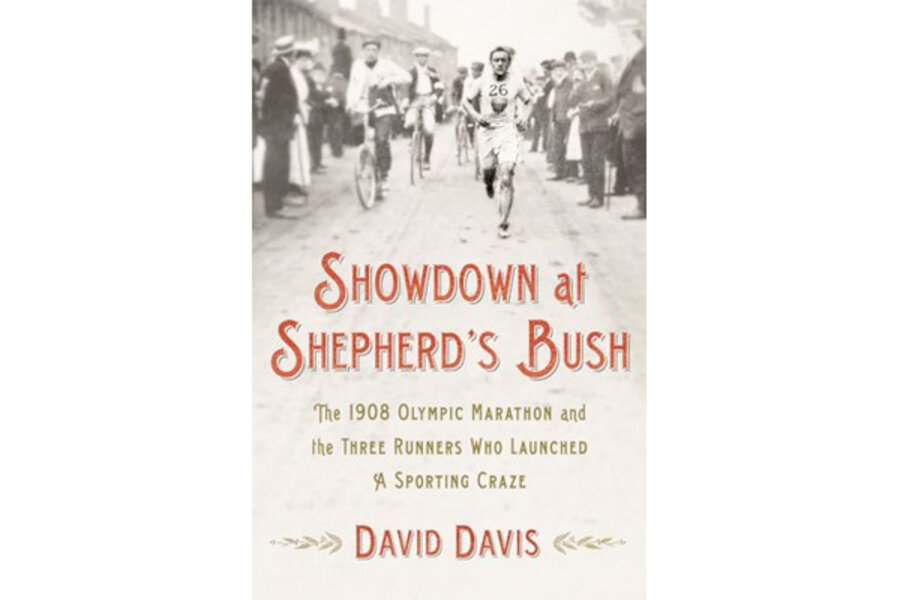Showdown at Shepherd’s Bush
Loading...
One of the most enduring photographic images from any Olympics is wobbly-legged Italian marathoner Dorando Pietri approaching the finish line with a various officials and British bobbies providing close escort. The year was 1908, at the first of three London Olympics, which makes the snapshot especially interesting as a field of male runners prepare to toe the line for the closing event at the current London Games.
The 1908 race is described as the most controversial in Olympic history by David Davis, who chronicles what happened before, during, and after this landmark event in Showdown at Shepherd’s Bush: The 1908 Olympic Marathon and the Three Runners Who Launched a Sporting Craze. The story focuses on three runners: Canada’s Tom Longboat, Italy’s Dorando Pietri, and America’s Johnny Hayes.
The controversy surrounds the end of the race, which saw 56 competitors head off on an uncharacteristically warm day in London from Windsor Castle.
As it turned out, Longboat, the pre-race favorite and an Onondaga Indian who hadn’t lost a race longer than 15 miles in thee years, dropped out well before the finish. Pietri was the first into the stadium. Confused, he began to circle the track in the wrong direction and had to be redirected. Exhausted, he collapsed on the cinders fives times, causing such concern that medical attendants came to his aid. Revived just enough, he staggered, accompanied by a phalanx of nonrunners, to victory – or so it appeared.
Hayes arrived next. American officials, however, felt he was the true winner and lodged a protest claiming that Pietri was unfairly assisted. When it was upheld, Pietri was disqualified and Hayes awarded the gold medal.
In retrospect, there was much that made this race and the 1908 Olympics, covered by Sir Arthur Conan Doyle for The Daily Mail, a fascinating moment in time.
For starters, the Olympics were still young and struggling. In fact, it wasn’t altogether clear – after a few “flops” – what the future held, so 1908 was a pivotal year for the Games. Adding to the challenge, Rome, which originally was scheduled to be the host, reneged on short notice in order to deal with the aftermath of Mt. Vesuvius’s eruption.
London, therefore, helped save the Games. The centerpiece of its hosting effort was a new 80,000-seat stadium, the first ever built for the modern Olympics. It was located in pasture land in West London known as Shepherd’s Bush and served as an all-in-one venue. Besides the running track, the stadium included a cycling track, a platform for gymnastics and wrestling, and a swimming pool in the infield. While the stadium was state of the art, announcements to the crowd were made using a large megaphone.
The packed stadium made a fitting end point for the marathon, which Pierre de Coubertin, the founding father of the modern Olympics, envisioned as a signature event. At least symbolically, it bridged the modern Games with Greece, where the myth of a war messenger’s valiant long-distance run from Athens to Sparta originated.
Although there was no official marathon distance, that used in London – 26 miles and 385 yards, allowing the race to finish in front of the stadium’s royal box – would become the international standard.
This was an early period in high-level sports competition generally, which showed itself on a number of fronts, including training. Pietri, for example, ran two marathons in the 45 days leading up to the Games, ill-advised preparation by today’s standards. Professionalism and drugs were also issues. Hayes, who once had been a New York subway tunnel digger, essentially was paid to train by Bloomingdale’s department store. And Longboat’s manager and promoter set up his charge as the proprietor of The Tom Longboat Athletic Cigar Store in Toronto from which Longboat sold products that bore his image.
The period after the 1908 marathon was a window on changing athletic fortunes and trends. Pietri would become “the man who won, but lost, and then won.” As a consolation for his heart-wrenching disqualification, Queen Alexandra presented him with a polished gold trophy. Film clips of the London race were shown in nickelodeons and vaudeville halls, which led to a New York promoter arranging two match races “at the full London distance” between Pietri and Hayes in smoke-filled Madison Square Garden. It was like a heavyweight prize fight atmosphere. The rivals even entered the arena wearing bathrobes.
Pietri won the first race of 262 laps around the cramped oval and a rematch to emerge as the superstar of a marathon mania, which spawned a flurry of prize money events that died out with the start of World War I in 1914.
Pietri, who become known to his fans simply as “Dorando,” lost his post-Olympics fortune, including a 54-room luxury hotel in his hometown of Carpi, after the war. Thereafter, he worked as a driver. He died in 1942, six years before the Olympics returned to London, where a street – Dorando Close – is named for him. The trophy the queen presented him for his heroic marathon effort reportedly remains in an Italian vault.








